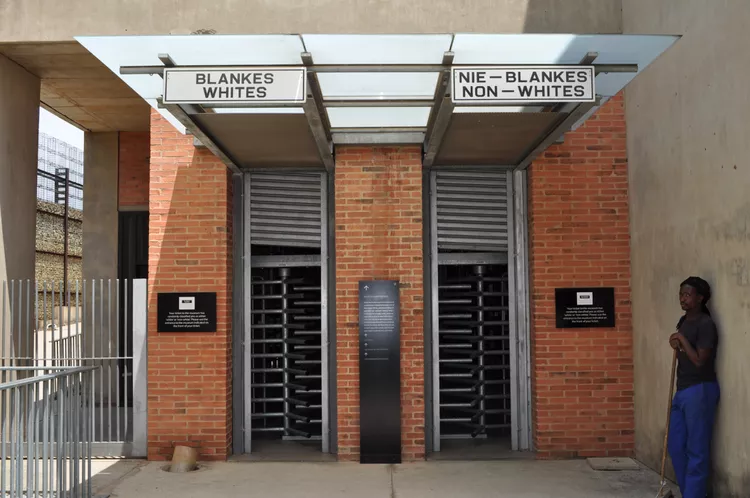Summary
Introduction to the Apartheid Museum
Northern Parkway and Gold Reef Road, Ormonde, Johannesburg, 2001, South Africa
Phone +27 11 309 4700
Visit website
Since 2001, the Apartheid Museum in Johannesburg has been the world’s leading authority on the events of the 20th century in South Africa. Located within the Gold Reef City entertainment complex, the museum offers emotional insights into the state-sanctioned racism and segregation that characterized the nation from 1948 to 1994. It meticulously chronicles the struggles of the South African people against apartheid and illustrates efforts toward a brighter future. For history enthusiasts, it is one of Johannesburg’s unmissable attractions.
What to See
The museum boasts 22 individual exhibition areas, each combining artifacts, photographs, film footage, and informative panels to narrate the rise and fall of apartheid and portray life in South Africa during this tumultuous period. Regular temporary exhibitions are also hosted, including one focused on the life of Nelson Mandela. The experience begins at the entrance, where guests are divided into “whites” and “non-whites,” entering through separate doors, showcasing the painful realities of a racially divided society.
Inside, exhibitions explore themes such as “Apartheid,” “The Turn to Violence,” “The Homelands,” and “The Truth and Reconciliation Commission.” The first theme delves into the social and political factors leading to apartheid’s establishment and highlights the laws underpinning it, along with photographs of forced relocations mandated by the Group Areas Act of 1950. The exhibition titled “The Turn to Violence” documents the decisions of the ANC and the PAC to form armed wings after the Sharpeville Massacre in 1960, featuring powerful photographs by Ernest Cole, a notable Black photojournalist who faced exile.
Nelson Mandela Sculpture
The Apartheid Museum features a small-scale replica of the Nelson Mandela sculpture located at the museum-affiliated Capture Site in KwaZulu-Natal. This original sculpture, erected in 2012 at the site where Mandela was arrested in 1962, represents a pivotal moment in history—his last day of freedom before enduring 27 years of imprisonment (initially at Constitution Hill and later at Robben Island). Created by sculptor Marco Cianfanelli, both the original and the replica consist of 50 poles that align to form an image of Mandela’s face.
The sculptures symbolize the notion that the collection of many forms a whole, recognizing Mandela as a universal representation of all who suffered under apartheid.
Rates, Hours & Location
The Apartheid Museum is situated at the intersection of Northern Parkway and Gold Reef Road in Ormonde, Johannesburg. It is open daily from 9:00 a.m. to 5:00 p.m., with closures on Good Friday, Christmas Day, and New Year’s Day. Visitors should plan for a minimum of two hours for their experience. Guided tours can be arranged for groups of 15 or more (excluding Mondays) and need to be scheduled in advance. Admission is priced at 95 rand ($6) for adults, 80 rand for pensioners, university students, and children, and 40 rand for school learners. An extra fee of 10 rand per person applies for guided tours.
Things to Do Nearby
For those looking to extend their visit, numerous attractions surround the Apartheid Museum. Gold Reef City stands as Johannesburg’s top entertainment venue, featuring a theme park, casino, two theaters, and a movie complex. History enthusiasts will appreciate the park’s underground mine tour, exploring Johannesburg’s inception amid the gold rush of the Transvaal in 1886. The complex includes two hotels (Gold Reef City Theme Park Hotel and Southern Sun Gold Reef City), facilitating an overnight excursion following your visit to the museum.
The museum also lies in proximity to various apartheid-era landmarks, such as Constitution Hill, the former prison that held Nelson Mandela and other resistance leaders, including Joe Slovo, Robert Sobukwe, and Albert Luthuli. The nearby Soweto township is steeped in apartheid history. Soweto Guided Tours provides a Soweto & Apartheid itinerary that combines a visit to the Apartheid Museum with tours of significant sites in Soweto, including Vilakazi Street, Mandela House Museum, and the Hector Pietersen Museum. Notably, Vilakazi Street is the only street globally that has been home to two Nobel Prize winners: Nelson Mandela and Desmond Tutu.




